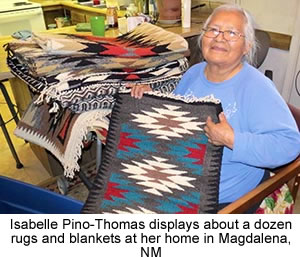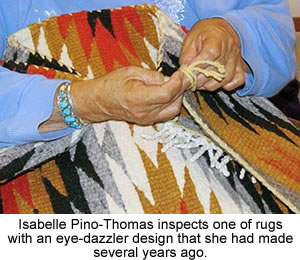 |
Canku Ota
|
 |
|
(Many Paths)
|
||
|
An Online Newsletter
Celebrating Native America
|
||
|
January 2014 - Volume
12 Number 1
|
||
|
|
||
|
Alamo Weaver: Weaving
Leads To A Good Life
|
||
|
by Colleen Keane - Special
to the Navajo Times
|
||
MAGDALENA and ALAMO, NM — When 78-year-old Isabelle Pino-Thomas was a little girl, she herded sheep to the Saltwater, Two Hill and Owl Nest areas of the Alamo Navajo Reservation. "That way my dad knew where I was at -- with the sheep," Thomas said identifying herself as a member of the Apache clan. Historically, Alamo people named certain places, like the areas Thomas took her sheep to pasture, as a way to find people or animals or to remember something that happened there. When the weather was good, Thomas said she walked two miles across the dry banks of the Rio Salado to go to the Alamo day school. When she wasn't at school or herding sheep in the high desert canyons and mountains of south central New Mexico, she watched her mother, Dora Guerro-Pino, create weavings in the distinctive double-weave, eye dazzler style of the Alamo Navajo. "It's thicker," Thomas said in comparison to weaving in Navajo communities 200 miles north on the main Navajo Reservation. But, Thomas was quick to say that her mother didn't give her step-by-step instructions. "I just watched," she said adding that when her mother thought she was ready, she took her to the next step in the learning process. "From the day my mom told me to separate the wool, I learned everything from her and started making yarns and strings." Thomas said it was a hard life living off the land without running water and electricity, but it taught her how to be productive and hard working. "Weaving helps you to think clearly and gets your mind off of whatever is bothering you," she said. Like an abrupt shift in the high-desert Alamo weather, Thomas's life changed dramatically in 1947 at age 12 when she was sent to a boarding school in Albuquerque about 170 miles away from Alamo. "It was lonely. I missed my parents, my sisters, my brother and my sheep," Thomas," she said. At the Albuquerque Indian School, she earned her high school degree and then went on to get training as a health aide and child care worker. A few years after her training was complete around 1960, she secured a job in Magdalena, N.M. at the dormitories where Alamo students lived while attending school, a place where Thomas worked for 26 years. While taking care of Alamo children as young as six, Thomas made sure that they had everything they needed - food, clothes, health care, help with their homework, love and attention. "I was like their mom. At nighttime, the children had nightmares not being home with their mothers. I was there for them," she said adding that she spoke to them in Navajo. She said she also showed them how to weave, teaching them the designs, patterns and processes, like her mother showed her. In the process, they also learned how to find the nuts, roots and plants needed to color the yarn. |
|||
|
|
||
|
|
||
| Canku Ota is a free Newsletter celebrating Native America, its traditions and accomplishments . We do not provide subscriber or visitor names to anyone. Some articles presented in Canku Ota may contain copyright material. We have received appropriate permissions for republishing any articles. Material appearing here is distributed without profit or monetary gain to those who have expressed an interest. This is in accordance with Title 17 U.S.C. Section 107. | ||
|
Canku Ota is a copyright ©
2000 - 2013 of Vicki Williams Barry and Paul Barry.
|
||
 |
 |
|
|
The "Canku
Ota - A Newsletter Celebrating Native America" web site and
its design is the
|
||
|
Copyright ©
1999 - 2013 of Paul C. Barry.
|
||
|
All Rights Reserved.
|
||

